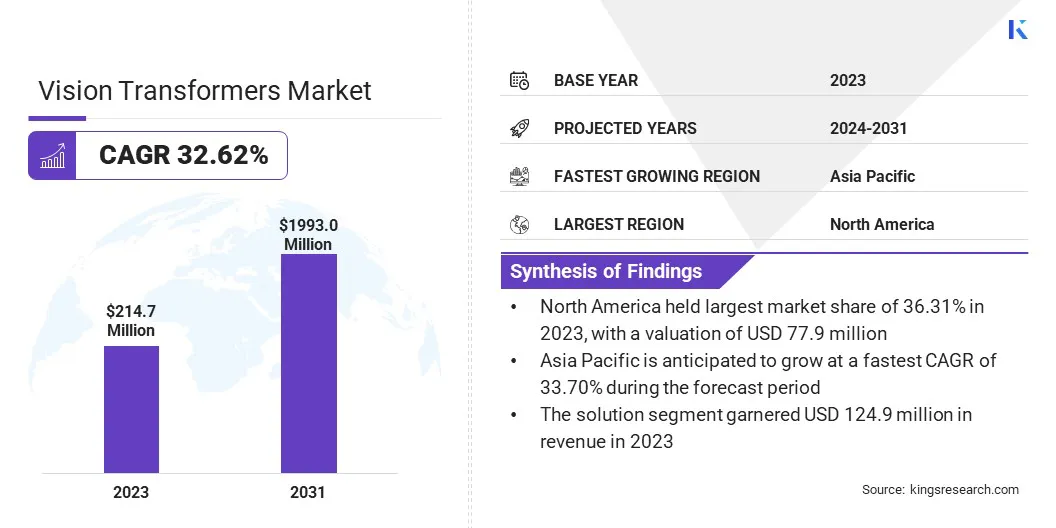Buy Now
Vision Transformers Market Size, Share, Growth & Industry Analysis, By Offering (Solution, Services), By Application (Image Classification, Image Captioning, Image Segmentation, Others), By End-Use Industry (Healthcare & Life Sciences, Retail and E-commerce, Automotive, Government and Defense, Others), and Regional Analysis, 2024-2031
Pages: 160 | Base Year: 2023 | Release: March 2025 | Author: Sharmishtha M.
The market encompasses the development and application of vision transformer models for image and video processing. ViTs excel in capturing long-range dependencies and contextual relationships, making them suitable for image classification, object detection, and scene understanding. Their capabilities are driving advancements in AI-powered computer vision applications across various industries.
Global vision transformers market size was valued at USD 214.7 million in 2023, which is estimated to be valued at USD 276.3 million in 2024 and reach USD 1,993.0 million by 2031, growing at a CAGR of 32.62% from 2024 to 2031.
Superior performance in complex tasks, such as image recognition and natural language processing, drives the growth of the market by delivering enhanced accuracy, scalability, and efficiency over traditional methods.
Major companies operating in the vision transformers industry are Google LLC, OpenAI OpCo, LLC, Meta, NVIDIA Corporation, LeewayHertz, Microsoft, Qualcomm Technologies, Inc., viso.ai, Clarifai, Inc., QUADRIC, Datature, Apple Inc., Innova Solutions, V7 Ltd, Ultralytics Inc, and others.
The market has quickly advanced, emerging as a key player in computer vision. Their strength lies in capturing long-range dependencies, offering greater flexibility and scalability than traditional models.
With continuous advancements in deep learning and AI technologies, ViTs are gaining traction across healthcare, automotive, and security industries. As demand for high-accuracy, real-time image processing solutions rises, ViTs are emerging as a preffered choice for AI-driven vision solutions.

Market Driver
"Superior Performance in Complex Tasks"
The ability of ViTs to achieve higher accuracy in complex computer vision tasks is fueling the growth of the vision transformers market. ViTs effectively capture global relationships within an image, while CNNs primarily detect local patterns such as edges and textures.
This capability enables ViTs to process complex visual data more efficiently, leading to their widespread adoption across various industries.
Market Challenge
"Memory Constraints"
Memory constraints present a significant challenge to the growth of the vision transformers market, particularly for large models handling high-resolution data. These models require substantial memory for processing multiple tokens and layers, limiting deployment on resource-constrained devices.
To address this challenge, techniques such as local attention, which partitions images into smaller segments, and optimized tensor layouts improve memory efficiency, reduce processing time, and enable seamless deployment while maintaining accuracy across diverse devices.
Market Trend
"Expansion into Specialized Applications"
The expansion of ViT into specialized domains such as digital pathology is emerging as a notable trend in the vision transformers market. These advanced models are adopted for precision diagnostics, enhancing image analysis accuracy in applications such as tumor detection and classification.
By processing large-scale, high-resolution medical images, the market is witnessing a shift toward efficient, automated systems that improve healthcare delivery and patient outcomes.
|
Segmentation |
Details |
|
By Offering |
Solution (Hardware, Software), Services (Consulting, Deployment & Integration, Training, Support, & Maintenance) |
|
By Application |
Image Classification, Image Captioning, Image Segmentation, Object Detection, Others |
|
By End-Use Industry |
Healthcare & Life Sciences, Retail and E-commerce, Automotive, Government and Defense, Others |
|
By Region |
North America: U.S., Canada, Mexico |
|
Europe: France, UK, Spain, Germany, Italy, Russia, Rest of Europe |
|
|
Asia-Pacific: China, Japan, India, Australia, ASEAN, South Korea, Rest of Asia-Pacific |
|
|
Middle East & Africa: Turkey, UAE, Saudi Arabia, South Africa, Rest of Middle East & Africa |
|
|
South America: Brazil, Argentina, Rest of South America |
Market Segmentation
Based on region, the market has been classified into North America, Europe, Asia Pacific, Middle East & Africa, and Latin America.
North America vision transformers market share stood at around 36.31% in 2023, valued at USD 77.9 million. This dominance is reinforced by the strong presence of tech giants, research institutions, and advanced healthcare infrastructure.
The U.S. and Canada lead in adopting cutting-edge AI technologies, including vision transformers, across sectors such as digital pathology, healthcare imaging, and gaming. In gaming, vision transformers enhance image quality and stability, contributing to significant advancements in AI-driven performance and realism.
Asia Pacific vision transformers industry is set to grow at a robust CAGR of 33.70% over the forecast period. AThis rapid growth fueled by advancements in AI and healthcare technologies across countries such as China, Japan, and India.
The increasing focus on precision medicine and digital health, combined with a growing investment in AI infrastructure, is creating a strong demand for vision transformers. Asia-Pacific's expanding healthcare industry and large-scale data generation position it at the forefront of AI-driven innovations.
The vision transformers market is experiencing significant growth, stimulated by the rising adoption of AI-powered solutions in autonomous technology.
Companies are advancing transformer-based models to improve object detection, 3D mapping, and real-time decision-making, enhancing safety and performance in autonomous applications. This innovation efforts are intensifying competition across the sector.
Recent Developments (Product Development/Partnerships/New Product Launch)
Frequently Asked Questions